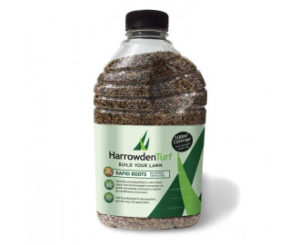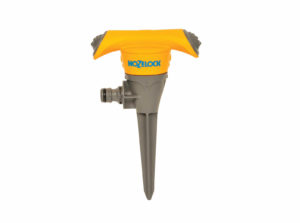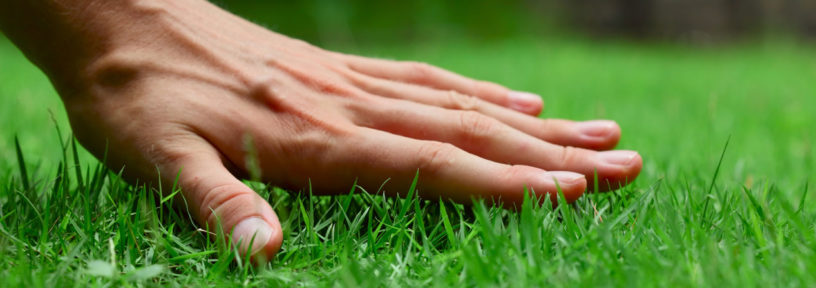Turf can be laid at any time of year, but in summer time, new turf needs extra TLC. Find out more in this blogpost.
What Does Turf Need To Establish?
In order to root into your garden, stay healthy and create a beautiful lawn turf needs:
- Sunshine
- Fresh Air
- Water
- Food
- TLC
In summer time, the most important (urgent) of these is water. Followed by sensible mowing.
Watering New Turf in Summer
Once turf has been successfully laid, the easiest way to kill it is to neglect the watering. In the Turfonline team’s experience, lack of water is the biggest killer of newly laid turf and the number one reason why people complain about dead lawns.
As soon as your lawn is laid – even before you have a cup of tea and a shower – you MUST water it really well. And I mean REALLY well. Soak it. You should have puddles on top of the grass that take at least 20 minutes to disappear. Come back in half an hour and lift the corner of one turf. The soil beneath it should be good and wet. Use your hand to move some of the soil to one side, check that the water has soaked down for at least 3 inches (8cm).
Do not go to bed until you are certain that the lawn has been watered enough. It it’s a hot night, check again in the morning before you go to work. If the soil seems dry, water the lawn before you go to work.
Make a point of watering EVERY evening and checking every morning for the next fortnight.
Watering not only sustains the turf and keeps it alive, it encourages the roots to drive deep into the soil. In the long term, deep roots are going to give you a more robust lawn.
Mowing New Turf in Summer
Long days, lots of light, warm weather and all that watering you’ve been doing will mean that your new turf will grow quickly.
Soon it will start to look a bit shaggy and you’ll be thinking about getting the lawnmower out. But don’t be too hasty or too enthusiastic with your mowing. Here are some guidelines to make sure that you help, not hinder your lawn’s establishment with your mowing regime.
Make sure your mower is fit for purpose
Would you want a surgeon to operate on you with a dirty blunt knife? Of course not. That would probably result in a very slow recovery and a high risk of disease. The same applies to your lawn. Don’t even think about mowing them unless the blades are sharp and spotlessly clean.
The grass plants that make up your new lawn have been under a lot of stress. They’ve had their roots cut off by a turf harvester, then they’ve been rolled up with no sunshine and travelled in the back of a lorry (which is hot and stuffy) before being re-laid in your garden. It’s up to you to nurture them and keep them safe whilst they recover.
It’ll take a couple of weeks for your lawn to bed in – so take the opportunity to get your mower cleaned and serviced.
Products that can help…
 |
 |
 |
 |
Don’t be in too much of a hurry to mow new turf
It’s not good trying to mow your new turf until it has well and truly rooted into your garden soil. If the bond between turf and soil is weak, the mower could lift the turves and really chew them up.
To test root strength tug on the grass. If you feel the turf lift slightly, it’s too soon to mow. If you end up with a handful of grass leaves, you’re good to go.
Don’t be tempted to mow too low
It’s tempting to try and create that velvety bowling green look from the outset. But close mowing is very stressful for grass. It doesn’t like it. Newly laid turf is especially vulnerable to being stressed by close mowing. It needs plenty of leaf surface to harvest the energy from the sun that is needed to grow new roots.
All you need to do with the first few cuts of your new lawn, is take the tips of the grass leaves. Have the mower on its highest setting, choose a dry day, and just tickle the surface of the lawn. It will immediately look neater and the grass will be encouraged to grow new shoots from the bottom.
A couple of days later, weather permitting, lower the blades by one notch and mow again.
Continue to mow little and often for the next month or so. The grass will continue to grow fast while you are watering it. Once watering stops, mow less frequently but keep the turf about 4-5cm long until the lawn is 2-3 months old.
Always collect the clippings at this stage of your lawn’s development.
Feeding your new turf
I’m assuming that you added pre-turfing fertiliser to the soil before laying your turf. If not, keep an eye out for pale leaves and for redthread disease. At the first sign of either, apply a spring-summer lawn feed EXACTLY as the manufacturer suggests.
Do not apply spring-summer lawn feed after the end of September – you’ll encourage lush growth which is susceptible to fusarium – a common autumn lawn disease.
In late September, your new lawn will benefit from an autumn-winter formulated lawn feed. This will strengthen the roots and help with winter hardiness.
For advice on caring for your new lawn
Explore our blog – there are lots of articles on there – or buy a copy of David Hedges-Gower’s new book “Modern Lawn Care”
You might find these articles helpful
Save

 A Summer Of Sunshine And Wild Flowers
A Summer Of Sunshine And Wild Flowers 

